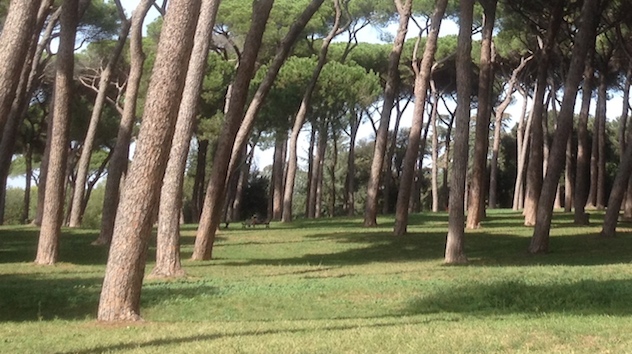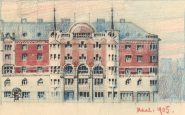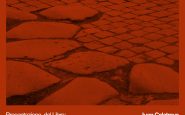« Indietro
Roma. La città e il suo doppio, Erik Söderblom – Villa Lante, ottobre 2014
Il 08/11/2014
"Roma. La città e il suo doppio / Rome. The city and its double" è il contributo di Erik Söderblom alla pagina 'Cultfinlandia_Architettura'. Il tema del 'viaggio in Italia' torna di piena attualità con il progetto culturale promosso dall'Institutum Romanum Finlandiae e si arricchisce delle suggestioni e visioni poetiche contenute nelle parole e nelle immagni di Erik Söderlund, direttore di Helsinki Festival. Questa è la cornice del progetto nelle parole del direttore dell'Institutum Romanum Finlandiae, prof. Tuomas Heikkilä.
------------------------------
"L’Institutum Romanum Finlandiae è stato già da sessant’anni un ponte per i finlandesi verso l’Europa. La rinascimentale Villa Lante al Gianicolo, sede dell’istituto, ha avuto un ruolo essenziale nel portare al livello internazionale la ricerca in scienze umanistiche come anche le arti visive del nostro paese. Nella vita culturale finlandese Villa Lante è un’icona.
Per vedere nel futuro si deve conoscere il passato – nella società odierna dove i valori hanno un ruolo sempre più centrale la conoscenza del patrimonio culturale europeo e della cultura umanistica è sempre più importante. Per rispondere a questa sfida l’Institutum Romanum Finlandiae ha cominciato nel 2006 i corsi per la promozione di scienze umanistiche, i cui partecipanti sono personalità di spicco della vita culturale, politica ed economica della Finlandia. Durante questi corsi lo scopo non è quello di memorizzare i dati storici ma piuttosto di esaminare la storia delle identità europee e la continuità culturale nella storia.
Il quinto corso di scienze umanistiche è stato tenuto a Roma dal 5 al 12 ottobre 2014. Gli otto partecipanti, sotto la guida del prof. Tuomas Heikkilä e del libero docente in storia d’Europa dott.ssa Liisa Suvikumpu, sono stati sollecitati alla ricerca del patrimonio culturale della Roma antica e alle sue influenze successive. In questo articolo Erik Söderblom, uno dei partecipanti al corso, racconta la sua esperienza."
Tuomas Heikkilä, direttore dell’Institutum Romanum Finlandiae
-----------------------------------
Rome – the city and its double, Erik Söderblom
La Roma. Like a mythological lioness she, in the mild warmth of October sun, lazily stretches herself out along the river Tevere. Proudly, like the queen that she is, she carries our futile attempts to find lines to describe her beauty. All attempts to ensnare her in words, all these songs of praise, sung by generations after generations of men and women bewildered by the confrontation, will, like the dust of time that sticks to her marbles, only increase her dignity.
Time against timelessness, momentariness against eternity, beauty against death, highest noblesse against utmost cruelty, fragility of life against power of life. This is Rome. The real, tangible city, consisting of layers upon layers, brought there by time, traces of human life, reaching many meters under the ground and forming what we call its history. But Rome in the collective subconscious of the western mind has a double, a sister Rome – the inner city of our mind, as multi-layered as its outward counterpart, an archetypal cityscape formed by the heritage of culture. Rome – and its inner reflection – the other Rome, the Rome of our dreams.
Tiina, Marja, Jorma, Jukka, Timo, Vesa, Päivi and me – the eight of us we walked around for eight days in this double city. How smoothly our guides transported us back and forth between the cities, the inner and the outer! Liisa and Tuomas. As with a touch of angel wings they sent us upon timeless paths leading backwards, inwards, down and up, towards the core of the core of the culture that has formed us and that we form.
The hidden doorways between Rome and Rome. A detail pointed out by our angel-pair of guides, an observation mentioned in a side-sentence of a side-sentence. Perhaps a deer’s horned head on the roof of the St. Eustachio Church. Or a golden stone among the black ones in the street marking the house of a Jew that vanished in the dark nights of horror of the Nazi era. Or the house corner that shows the site and shape of the medieval tower now embedded in later buildings. Or the tracks, formed by thousands and thousands of wagon-wheels dragged along the street-stones of Forum. Or the hundreds-of–years old graffiti on the wall of Villa Lante, telling the day of the invasion of Rome by a feared enemy. Or the empty beds in the separate bedrooms of il Duce and his wife in Villa Torlonia … It is as if they all ask the same question: how shall we humans live to lead a human life?
Rome, a city reflecting a city, thoughts reflecting thoughts in the mirror-hall of the mind. Liisa and Tuomas opened the city like a book, the pages filled with signs of hidden meaning. The marbles started to whisper their stories. Rome was now not the city I know – or thought that I knew - it was a totally different place. And still – unlike earlier times - it was like a home-coming. Like coming home to a place where you have never been, or meeting a relative you didn´t know existed. We are all children of Rome.
The light, the weight of it. The full-bodied, somehow ripe light over Rome. That stays in my inner vision, when October turns into November and we here up in the north, beyond ultima thule, dive into the darkness of winter. The outer Rome I cannot carry with me, but the inner I can. I carry it because it is my city, the city where I was born.
Erik Söderblom, direttore di Helsinki Festival
------------------------------
"L’Institutum Romanum Finlandiae è stato già da sessant’anni un ponte per i finlandesi verso l’Europa. La rinascimentale Villa Lante al Gianicolo, sede dell’istituto, ha avuto un ruolo essenziale nel portare al livello internazionale la ricerca in scienze umanistiche come anche le arti visive del nostro paese. Nella vita culturale finlandese Villa Lante è un’icona.
Per vedere nel futuro si deve conoscere il passato – nella società odierna dove i valori hanno un ruolo sempre più centrale la conoscenza del patrimonio culturale europeo e della cultura umanistica è sempre più importante. Per rispondere a questa sfida l’Institutum Romanum Finlandiae ha cominciato nel 2006 i corsi per la promozione di scienze umanistiche, i cui partecipanti sono personalità di spicco della vita culturale, politica ed economica della Finlandia. Durante questi corsi lo scopo non è quello di memorizzare i dati storici ma piuttosto di esaminare la storia delle identità europee e la continuità culturale nella storia.
Il quinto corso di scienze umanistiche è stato tenuto a Roma dal 5 al 12 ottobre 2014. Gli otto partecipanti, sotto la guida del prof. Tuomas Heikkilä e del libero docente in storia d’Europa dott.ssa Liisa Suvikumpu, sono stati sollecitati alla ricerca del patrimonio culturale della Roma antica e alle sue influenze successive. In questo articolo Erik Söderblom, uno dei partecipanti al corso, racconta la sua esperienza."
Tuomas Heikkilä, direttore dell’Institutum Romanum Finlandiae
-----------------------------------
Rome – the city and its double, Erik Söderblom
La Roma. Like a mythological lioness she, in the mild warmth of October sun, lazily stretches herself out along the river Tevere. Proudly, like the queen that she is, she carries our futile attempts to find lines to describe her beauty. All attempts to ensnare her in words, all these songs of praise, sung by generations after generations of men and women bewildered by the confrontation, will, like the dust of time that sticks to her marbles, only increase her dignity.
Time against timelessness, momentariness against eternity, beauty against death, highest noblesse against utmost cruelty, fragility of life against power of life. This is Rome. The real, tangible city, consisting of layers upon layers, brought there by time, traces of human life, reaching many meters under the ground and forming what we call its history. But Rome in the collective subconscious of the western mind has a double, a sister Rome – the inner city of our mind, as multi-layered as its outward counterpart, an archetypal cityscape formed by the heritage of culture. Rome – and its inner reflection – the other Rome, the Rome of our dreams.
Tiina, Marja, Jorma, Jukka, Timo, Vesa, Päivi and me – the eight of us we walked around for eight days in this double city. How smoothly our guides transported us back and forth between the cities, the inner and the outer! Liisa and Tuomas. As with a touch of angel wings they sent us upon timeless paths leading backwards, inwards, down and up, towards the core of the core of the culture that has formed us and that we form.
The hidden doorways between Rome and Rome. A detail pointed out by our angel-pair of guides, an observation mentioned in a side-sentence of a side-sentence. Perhaps a deer’s horned head on the roof of the St. Eustachio Church. Or a golden stone among the black ones in the street marking the house of a Jew that vanished in the dark nights of horror of the Nazi era. Or the house corner that shows the site and shape of the medieval tower now embedded in later buildings. Or the tracks, formed by thousands and thousands of wagon-wheels dragged along the street-stones of Forum. Or the hundreds-of–years old graffiti on the wall of Villa Lante, telling the day of the invasion of Rome by a feared enemy. Or the empty beds in the separate bedrooms of il Duce and his wife in Villa Torlonia … It is as if they all ask the same question: how shall we humans live to lead a human life?
Rome, a city reflecting a city, thoughts reflecting thoughts in the mirror-hall of the mind. Liisa and Tuomas opened the city like a book, the pages filled with signs of hidden meaning. The marbles started to whisper their stories. Rome was now not the city I know – or thought that I knew - it was a totally different place. And still – unlike earlier times - it was like a home-coming. Like coming home to a place where you have never been, or meeting a relative you didn´t know existed. We are all children of Rome.
The light, the weight of it. The full-bodied, somehow ripe light over Rome. That stays in my inner vision, when October turns into November and we here up in the north, beyond ultima thule, dive into the darkness of winter. The outer Rome I cannot carry with me, but the inner I can. I carry it because it is my city, the city where I was born.
Erik Söderblom, direttore di Helsinki Festival




